|
< Earlier Kibitzing · PAGE 37 OF 39 ·
Later Kibitzing> |
May-06-20
 | | AylerKupp: <beatgiant> An interesting chess variant. Kramnik's aim appears to be to "find a chess variant that would not only have the potential to bring the excitement and decisive victories back to chess, but is also aesthetically pleasing." And his goal was "to reignite interest and introduce players and audiences to the immense complexity and creativity of the original game of chess." ---
But I think that his enthusiasm gets the better of him when towards the end of his article he says "A tournament using this variant will definitely see a significant increase in the number of decisive games—far beyond 50 percent, I estimate", claims that are not substantiated by any data he presents. The game results data from chess data bases such as ChessTempo show that for players at all rating levels White wins 38.6% of the games and loses 30.5% of the games, so for average players the number of decisive games is already almost at the 70% mark. Only when both players are rated above 2500 does the number of decisive games fall below the 50% mark, and these games represent only 7.5% of the total games in the database. The use of AlphaZero to support his aim seems like an overkill to me, requiring not only access to AlphaZero and its required TPUs but also to a training session to modify AlphaZero's neural net's weights and biases to reflect the deletion of the castling rules. In contrast, modifying Stockfish 11 seems like only a 1-line change in the types.h file to change ANY_CASTLING = WHITE_CASTLING | BLACK_CASTLING, to ANY_CASTLING = NO_CASTLING and recompiling. Then you can run Stockfish 11NS (no castling) against Stockfish 11NS games at your heart's content and see if there is a significant change in the number of decisive games at various time controls without the castling options compared to the number of decisive games at various time controls with the castling options But I do like his concept, and it would be nice to see if someone is sufficiently interested in making that modification to Stockfish 11 and running a sufficient number of Stockfish 11NS vs. Stockfish 11NS tournaments to see what the increase in the number of decisive games actually is. |
|
May-06-20
 | | beatgiant: <AylerKupp>
You probably meant to reply to <keypusher>, not me. I do have thoughts about these things but not a lot of time to post in sufficient depth to get them across. |
|
May-07-20
 | | keypusher: < AylerKupp:
---
But I think that his enthusiasm gets the better of him when towards the end of his article he says "A tournament using this variant will definitely see a significant increase in the number of decisive games—far beyond 50 percent, I estimate", claims that are not substantiated by any data he presents. >I don’t doubt that you’re right. But do check out the two games that he annotates, they are something else. |
|
May-07-20
 | | AylerKupp: <beatgiant> Sorry about that, I don't know what happened to me. And re-reading my post I saw multiple references to my hypothetical Stockfish 11NS which I even identified as (no castling)! It obviously should have been Stockfish 11NC. And I can't even blame the keyboard since the letter "C", while close, is not adjacent to the letter "S", and us touch typists would be pressed with a different finger. I must have had a bad day.
And when you do have time please post your thoughts. I would be interested in them. Seriously. |
|
May-07-20
 | | AylerKupp: <keypusher> I did look at both games annotated by Kramnik and you're right, they're both great games, showing AlphaZero's predilection for early a- and h-pawn pushes. It was very interesting to see how AlphaZero, as Black, tries to counter it's own approach! And about Kramnik's remark in game 1 about 46...b5 requiring some accurate calculation, he apparently doesn't know how AlphaZero's position evaluation function works. It would have been very interesting, at least to me, to display the scoring % that each side calculated for each move because, being probabilistic, they would likely be different for either side, just like different classic engines have different evaluation functions and so could very well have different evaluations of different positions. I've seen AlphaZero's Ke1-f1 in other games, whether forced or not. After all, once the h-pawn is pushed, the rook belongs on h1 to support its advance and take advantage of any possible opening of the h-file. And both sides have to do something about providing additional safety to their kings. Black's 13...Ke7 in game 2 is another example of trying to do that, but somewhat more dramatic as it exposes Black's king to White's pressure on the e-file. It made me think that perhaps Black should have played 15...Kf8 instead of 15...c5 to at least delay d4-d5. But what do I know? My initial thought about 5.Nc3 in game 2 and Kramnik's comment on it is that AlphaZero was maybe being a little too dogmatic. After all, he had a space advantage with White and Black's pieces will be somewhat cramped. And, if your opponent is cramped for space, one of chess' maxims is that you should avoid exchanging pieces. Maybe the explanation is as simple as that. By now we've all seen AlphaZero's prowess in chess so we should not be surprised that they were good and games. But Kramnik's thesis was not that the no castling games would be more exciting but that they would "not only have the potential to bring the excitement <and decisive victories> back to chess, but is also aesthetically pleasing." So showing two drawn games, while certainly being aesthetically pleasing, don't seem to support his claim that they would "bring the excitement and decisive victories back to chess." At any rate, 2 games are, while nice examples, hardly a statistical sample to support his later claims that "A tournament using this variant will definitely see a significant increase in the number of decisive games", nor is his listing of 10 games when 90% of them ended in draws. But, as I said originally, I like the no castling concept. That made me curious as to the origins of castling and the reasons for it. Apparently it dates back to the 16th century or even earlier after the bishop and queen acquired their current freedom of movement, they were originally restricted in their movement and they were relatively weak pieces. As a result the king was relatively safe in the middle of the board. But afterwards ways to improve the king's safety were sought, and castling was the form that won out over other suggestions to make the king more mobile and better able to avoid its tormentors. It seems ironic to me that, given that the development of the techniques for defense lagged behind the development of the techniques for attack, that the concept of improving king safety might have been the result of <too many> decisive games. And now that the perception is that there aren't <enough decisive games> that deleting the castling rule has been proposed. I suppose that what goes around, comes around. |
|
May-07-20
 | | AylerKupp: <keypusher> And with respect to Kramnik's enthusiasm, that seems reflected by the number of exclamation marks he used in his analysis of the second game. Fifty eight of them, including the moves resulting from his analysis! That seems to me an unusually large number of good moves, no matter how brilliant the game. But that's just my opinion. |
|
| May-09-20 | | dannygjk: The moves are brilliant when looking at them as if they had been played by humans. For an engine of course it's different. |
|
May-09-20
 | | alexmagnus: < In contrast, modifying Stockfish 11 seems like only a 1-line change in the types.h file to change ANY_CASTLING = WHITE_CASTLING | BLACK_CASTLING, to ANY_CASTLING = NO_CASTLING and recompiling> But would the resulting evaluations be correct? After all, some part of the evaluation is based on the static features of the position, and I wonder how lack of castling changes the evaluation of those. |
|
| May-09-20 | | diceman: <keypusher:
It features an absolutely astounding game, also covered in an agadmator video.> Interesting, the questions would be, are those tactics the result of no-castle chess,
or AlphaZero's incredible ability to play tactical chess? I suspect the latter, there seems to be no reason (especially with humans) why you can't play "dry" positional chess without castle. |
|
| May-09-20 | | diceman: To see what Stockfish does with a no castle rule, I took this position: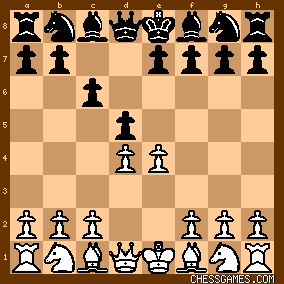
click for larger view...and played: 3. Ke2 Kd7 4. Ke1 Ke8 putting Sockfish in the same position as AlphaZero. I let SF think 30 ply, took its variation out
to move 10, let it think 30-ply from there, took its variation out to move 20,
let it think 30-ply from there and so on.
This is the game it came up with:
1. e4 c6 2. d4 d5 3. Ke2 Kd7 4. Ke1 Ke8 5. Nd2 dxe4 6. Nxe4 Nf6 7. Nxf6+ gxf6 8. Nf3 h5 9. h3 e6 10. c3 c5 11. Be3 Qc7 12. Be2 cxd4 13. Qxd4 e5 14. Qe4 Be6 15. Nh4 Nc6 16. Qf3 Rg8 17. Qxh5 Rd8 18. Kf1 Ne7 19. Bb5+ Bd7 20. Bxd7+ Rxd7 21. Kg1 Rd5 22. g3 f5 23. Re1 Qc4 24. Kh2 f4 25. Bc1 e4 26. Qe2 fxg3+ 27. fxg3 Qxe2+ 28. Rxe2 f5 29. Rd2 Rxd2+ 30. Bxd2 Kf7 31. Rd1 Ke6 32. Bf4 Nd5 33. Bc1 f4 34. gxf4 Bd6 35. Ng2 Nf6 36. Re1 b5 37. Be3 Kf5 38. b3 Nd5 39. Nh4+ Kf6 40. Bd4+ Kf7 41. Rxe4 Bxf4+ 42. Kh1 Rg3 43. Nf5 Rxh3+ 44. Kg2 Rh5 45. Ne7 Bd6 46. Nxd5 Rxd5 47. Rh4 Rg5+ 48. Kf3 Ke6 49. Ke4 a5 50. a4 Kd7 Position halfway through after black's 25th move: 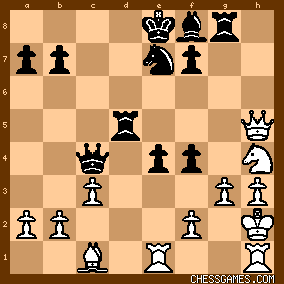
click for larger viewFinal Position after move 50 by black:
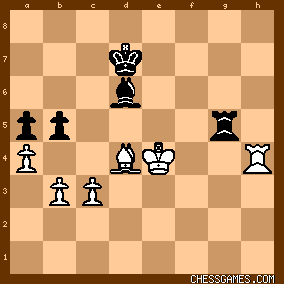
click for larger viewI haven't looked if the final position is a win? Id certainly rather be up the pawn. Most of the time this evaluated +1.0.
Black's problems came from his busted kingside pawns, and the fact that he eventually lost one. It certainly isn't tacticial at the AlphZero level. My guess is, if I let SF think longer, it would have been more equal. |
|
May-09-20
 | | AylerKupp: <<alexmagnus> But would the resulting evaluations be correct?> It would depend on what you mean by "correct". To me "correct" means "accurate", i.e. how close is an evaluation to the "real" (and unknown) <absolute> assessment of the position. That is essential to someone using an engine for analysis, they want to know after a given move whether the position is even, either side having a small advantage, a large advantage, or a winning advantage. But engines gain their reputation by their playing strength, i.e. how well they perform in games against other engines. And when playing games <absolute> evaluation accuracy is irrelevant, what counts is <relative> evaluation accuracy, whether one move than another. This is because the minimax algorithm used by the "classic" engines perform a set of pairwise comparisons between two moves to determine which move should be promoted up the search tree. And whether you add a constant to the evaluations, multiply the evaluations by a constant or by a monotonically changing function the engine will always select the same move as being better than the other move. Stockfish, for example, typically gives notoriously higher evaluations than other engines. Are they more correct than the evaluation of the other engines? Who knows? That's why when doing serious analyses I have 3 different engines analyze the same position and average their evaluations. This tends to dampen Stockfish's enthusiasm if you allow me to anthropomorphize a little. <some part of the evaluation is based on the static features of the position, and I wonder how lack of castling changes the evaluation of those.> You said it, "some part of the evaluation is based on the static features of the <position>". The positions would be evaluated with the king in or near the center, unless the engine decides it's best for the king to take a walk. Whether the king got to its square in the position by castling or through a combination of a rook lift and several moves is not relevant to the assessment of the position. And, of course, in this case castling would not be considered a valid candidate move. In Stockfish 11 this is encapsulated in the movegen.cpp file. For example, I use Arena 3.5 as my GUI. Prior to analyzing a position I have to specify the "Castling Possibilities", whether White and/or Black is allowed to castle short or castle long. The default is No and since most of the analysis are done during the middlegame or endgame after the kings have likely castled, that's the proper default. But I have to keep this specification in mind when analyzing opening or early middle game positions since, by habit, I sometimes forget and have to redo the analysis because, of course, the resulting evaluation is worthless. And Arena also allows you to select one of 3 chess variants; Normal chess, Chess 960, and Shuffle Chess. Adding a No Castling chess variant should be relatively simple, just inhibit the Castling Possibility specifications. Since I think that a No Castling variant would be an interesting option I would like to suggest to its developers to add this variant but I don't think that Arena is being supported any more (the last version, Arena 3.5.1, was released in 2015). Does anybody know if it is still supported and, if it is, how I can contact them to make this request? |
|
May-10-20
 | | Eggman: My brother was telling me about an AlphaZero game where it simply put its bishop where it could be captured by a pawn - more or less a positional bishop sacrifice, as my brother described it. When I asked him to send me a link to the game, he couldn't find it. Would anyone know what game he was referring to? |
|
| May-10-20 | | Jambow: <Eggman> This might be it... AlphaZero vs Stockfish, 2017 |
|
May-11-20
 | | keypusher: < diceman: <keypusher:
It features an absolutely astounding game, also covered in an agadmator video.> Interesting, the questions would be, are those tactics the result of no-castle chess, or AlphaZero's incredible ability to play tactical chess? I suspect the latter, there seems to be no reason (especially with humans) why you can't play "dry" positional chess without castle.> Yeah, I agree with you...in fact it looks like you more or less proved your own proposition with SF. Which is why I think people are wrong to slight FR/960. Some of us can play boring chess from any setup, but 960 seems to make it harder. <eggman> <jambow> Bet <jambow> is right, but another possibility is: AlphaZero vs Stockfish, 2018 |
|
May-25-20
 | | keypusher: Since for whatever reason LeelaChessZero still doesn't have its own page: TCEC Season 17 Superfinal Game 96. LCZero v0.24-sv-t60-3010 v. Stockfish 20200407DC. This game, I understand, clinched LC0’s victory in the 17th TCEC superfinal. In the TCEC final, openings are chosen for the engines. SF is required to play the black side of a stodgy French Defense, probably not an opening its programmers would have chosen for it. (To be fair, LC0 wouldn’t have chosen to play it with Black either, but nevertheless was forced to, and won in Petrosian style.) LC0 gives away a pawn in the opening but keeps a grip on e5 in good Nimzowitsch style. It’s said that when strong GMs play, the brilliancies tend to be left in the notes. That is definitely the case here. LC0 repeatedly offers a second pawn, which SF refuses. There were some blow-you-away tactics if Black had taken the second pawn. Instead, LC0 gets a permanent bind on the position. SF can trade pieces off, and does, but can’t get unsnarled or develop any play of its own.
SF is gradually able to trade pieces but is never able to get free or develop any kind of play. Finally it just starts giving pawns back, eventually getting to a hopeless ending.
1.e4 e6 2. d4 d5 3. e5 b6 [last book move] 4. h4 c5 5. c3 Nc6 6. Nf3 Bd7 7. Bd3 Qc7 8. O-O cxd4 9. Bf4 (SF +0.70 55 ply. Interestingly, my desktop SF10 was also in favor of sacrificing a pawn here, though it preferred 9.Re1.) 9…a6 10. a3 dxc3 11. Nxc3 b5 12. Rc1 Qb6 13. Be3 Qb8 (13….d4 14.Nxd4 Nxd4 15.Be4 and White wins) 14. Re1! Nge7
Adagmator gives some easy variations where Black gets killed after 14….Nxe5 15.Nxd5. More interesting and complicated are the variations if Black grabs the pawn on either of the next two moves. 15. b4! h6
( 15... Nxe5 16. Nxe5 Qxe5 17. Bc5 Qb8 18. h5 h6 19. Qg4 Qd8 20. Qf4 Qb8 21. Qe3 Qb7 22. f4 f5 (seemingly necessary) 23. Ne2 Nc6 24. Bxf5 Bxc5 25. Bg6+ Kd8 26. Rxc5 Rc8 27. f5 exf5 28. Nd4 Qb6 29. Rxd5 Nxd4 30. Rxd4 Rc6 31. Qe7+ Kc7 32. Qxd7+ Kb8 33. Bxf5; 15….Ng6 16.h5! Ngxe5 17. Nxd5 exd5 ( 17... Nxf3+ 18. Qxf3 Bd6 19. Nb6 ) 18. Bf4 Bd6 19. Rxc6 Bxc6 20. Nxe5 O-O 21.Nxc6 +-) 16. h5! Qb7 ( 16... Nxe5 17. Bf4 Nxf3+ 18. Qxf3 Qb6 19. Bc7!! Qxc7 ( 19... Qd4 20. Ne2 Qf6 21. Qe3 Nf5 22. Bxf5 Qxf5 23. Qb6 Be7 24. Nd4 Qxh5 25. Nc6 Bg5 26. Qc5 Rc8 27. Qd6 Rxc7 28. Qxc7 O-O 29. Qxd7 Bxc1 30. Rxc1 and White wins) 20. Nxb5 Qb8 21. Nc7+ Kd8 22. Qxf7 Ra7 23. Nxe6+ Bxe6 24. Rxe6 g5 25. Bf5 a5 26. Rc5 Rd7 27. Bg6 Bg7 28. Qxg7 Nxg6 29. Qf6+ Re7 30. hxg6 Re8 31. Rxe7 Rxe7 32. g7+-)
But does any of this matter? Does White even need to offer the pawn? For example, can’t LC0 just play 15.Bf4 with something similar to the game? Well, in that case, Black may be able to untangle with 15….Na5. The main line continues 16.h5 Nc4 17.b3 Nb2 18.Qc2 Nxd3 19.Qxd3 Qb7 20.Nd4 Nc6 21.Nxd5! h6! 22.b4 Rc8 23.Ne3 Nxd4 24.Rxc8+ Bxc8 25.Qxd4 (+0.33, 42 ply). Not a picnic, but easier than the game, for after 17.Bf4 in the game line

click for larger view |
|
May-25-20
 | | keypusher: Part 2
…it’s very hard for SF to undertake anything. Neither knight has anywhere to go. If Black tries …a6-a5, Nxb5 threatening Nd6+ is fatal. Moving the f- or g-pawns will leave Black with fatal weaknesses on the kingside. The light-square bishop is very bad, while the knight on e7 blocks the other bishop, which obstructs the rook. 17….d4 more or less loses after 18.Ne2 Nd5 19.Be4. There is very little Black can do except wait and try to trade pieces. 17….Rc8 18. Qd2 Rc7 19. Bg3 Rg8
Here, for example,19… Nc8 loses to 20. Nxd5! exd5 21. e6 fxe6 22. Bxc7 Qxc7 23. Bg6+ Kd8 24. Nd4 N8a7 25. Nxe6+ Bxe6 26. Rxe6 Qd7 27. Bf5 Bd6 28. Re5 Qb7 29. Rxd5 . 20. Rc2 Rc8 21. Ne2 Na7 22. Nfd4 Rxc2 23. Qxc2 Nac6 24. Bh7 Rh8 25. Bd3 Rg8 26. Bh7 Rh8 27. f4 Nxd4 28. Nxd4 Qc8 29. Rc1 Qxc2 30. Bxc2 Nc6 31. Bf2 
click for larger view31….Nb8. Obviously a key moment. Can’t Black exchange knights, too? Apparenlty, not, according to some really long SF lines: 31... Nxd4 32. Bxd4 Be7 33. Bd3 Kd8 34. g4 Rg8 35. Kh2 Rh8 36. Kg2 Rg8 37. Kg3 Rf8 38. Rc2 Rg8 39. f5 exf5 40. Bb6+ Ke8 41. gxf5 Bg5 42. Kf3 Rh8 43. Bc7 Rg8 44. Bd6 Bd8 45. Ke3 Bb6+ 46. Kf4 Bd8 47. Bc7 Ke7 48. Bb8 Ke8 49. Ba7 Bg5+ 50. Kf3 Ke7 51. Bc5+ Kd8 52. Bb6+ Ke8 53. Rc3 Rh8 54. Bc7 Bd8 55. Bd6 Bb6 56. Rc2 Bd8 57. Ke3 Bb6+ 58. Bc5 At this point, after a lot of tacking, Black starts making committal moves, so here is another diagram: 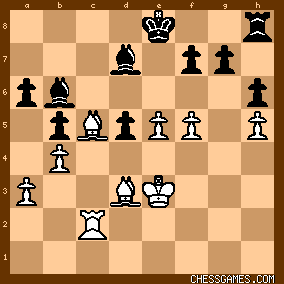
click for larger view….Bxc5+ ( If 58... Bd8, then 59. Ba7 Rg8 60. Kd4 and wins; if 58... Bc7 59. Bd4 Bb8 60. e6! fxe6 61. Bxg7 Rg8 62. f6 and wins) 59. bxc5 f6 60. c6 fxe5 61. cxd7+ Kxd7 and White should win.
32. Bd3 Be7 33. Rc7 Kd8 34. Rc2 Ke8 35. g4 Rg8 36. Kg2 Kd8 37. Kg3 Rh8 38. Rc1 Rg8 39. Bg1 g6 Does Black have to do this? Apparently, yes, or something like it. If Black continues to shuffle, then after 39… Rf8 40. Rc2 Rh8 41. f5 Bg5 42. fxe6 Bxe6 43. Nxe6+ fxe6 44. Bb6+ Ke7 45. Rc7+ Nd7 46. Bc5+ Kd8 47. Bd6 Be3 48. a4 Bd4 49. axb5 Bxe5+ 50. Bxe5 Nxe5 
click for larger view51. b6!! Rf8 (51….Nxd3 52.Ra7 +-) 52. Bxa6 Rf3+ 53. Kg2 Rf4 54. Rc8+ Ke7 55. b5! Rxg4+ 56. Kh3 Rf4 57. b7 Nd7 58. b6! Rf3+ 59. Kh4 Rf4+ 60.Kg3 +-. But now Black is going to be left with fatal pawn weaknesses. |
|
May-25-20
 | | keypusher: Part 3
40. hxg6 fxg6 41. Be3 h5 42. g5 Ke8 43. Rc7 Kf7 44. Bb1 Rd8 45. Nf3 d4
Not much choice given the threat of Nh4. SF10 at a shallow search is well over +4 at this point. 46. Nxd4 Rc8 47. Rb7 Rd8 48. Be4 Re8 49. Kf2

click for larger view49….h4.
<49….Rc8 50.Nf3 Bc6 51.Bxg6+ isn’t better.> 50. Kg2 Rc8 51. Bf2 Be8 52. Rb6 Bd7 53. Kh2 a5 54. bxa5 Bd8 55. Rb7 Bxa5 56. Nxb5 Kg8 57. Nd6 Rf8 58. Be3 Bc6 
click for larger view59. Bxc6.
Here SF10 thinks 59.Re7 would have won a lot quicker (+6.93, 30 ply). This is one of several points in the ending where, if you switched colors, SF probably would have won more quickly than LC0 did. This also happened in some of the A0-SF games. NN engines don’t seem to put a premium on efficiency. 59....Nxc6 60. Ne4 Rf7 61. Rxf7 Kxf7 62. Bf2 Ne7 63. Bxh4 Nd5 64. Bg3 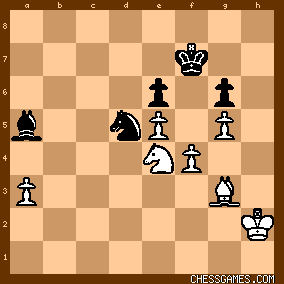
click for larger viewAs Bronstein wrote during the late stages of Smyslov vs Euwe, 1953, Black has not stood this well in some time; unfortunately he’s two pawns down. 64....Bc7 65. Kh3 Ba5 66. Kg4 Ke7 67. Bf2 Kd7 68. Kf3 Kc6 69. Be3 Bc3 70. Bc1 Bd4 71. Ke2 Bc5 72. Kd3 Bf8 73. Kc4 Nb6+ 74. Kc3 Be7 75. Kd3 Nd5 76. Kc4 Bd8 77. Nf6 Nb6+ 78. Kb3 Na8 79. Bd2 Bb6 80. a4 Nc7 81. Kc4 Ba7 82. Kd3 Bc5 83. Ne4 Bf8 84. Kc4 Ba3 85. Nc3 Na6 86. Be3 Bb4 87. Ne2 Be1 88. Nd4+ Kd7 89. Nb3 Kc6 90. a5 Bg3 91. Nd4+ Kd7 92. Bd2 Bh2 93. Ne2 Kc6 94. Be3 Nc7 95. Bc1 Nd5 96. Bd2 Ne7 97. Kd3 Kb7 98. Ke4 Nf5 99. Kf3 Nh4+ 100. Kg4 Nf5 101. Kh3 Bg1 102. Nxg1 Nd4 103. f5 exf5 104. Be3 Ne6 105. Ne2 f4 106. Nxf4 Nxg5+ 107. Kg4 Nf7 108. Nxg6 Ka6 109. Kf5 Nxe5 1-0 |
|
May-26-20
 | | AylerKupp: <<keypusher> NN engines don’t seem to put a premium on efficiency.> That would make sense. NN engines use MCTS and select as the move to be played the move that maximizes its scoring probability. Thus, if two moves will likely lead to a win but the move that achieves that in a shorter sequence of moves has a lower scoring probability, NN engines will play the move that has a higher scoring probability even though it would take it longer to win. After all, chess engines don't get tired. Which is somewhat ironic since most classic chess engine nowadays use the Syzygy tablebases (I don't know of any NN engines that use tablebases at all) because they are more compact since they don't have any distance-to-mate information. So they will know that several lines would lead to a win but they wouldn't know which line achieves the win in the least amount of moves. It might be interesting as an experiment to have two versions of Houdini 6 Pro analyze a number of endgames, one using Syzygy tablebases and one using Nalimov tablebases (which do contain distance-to-mate information; Houdini 6 Pro supports both). I would think that the version using Nalimov tablebases would find the most efficient (i.e. shortest) winning sequence much more often than the version using Syzygy tablebases. |
|
Jun-02-20
 | | keypusher: <AK> Thanks.
<59. Bxc6.
Here SF10 thinks 59.Re7 would have won a lot quicker (+6.93, 30 ply).> I was looking at the diagram at this point and suddenly thought to myself, "why can't White play 59.Rxb8 and get two pieces for a rook?". The short answer is that it can, but the Black rook gets quite active. White is still winning after something like 59. Rxb8 Rxb8 60. Bxc6 Rb2+ 61. Kh3 Rb3 62. Nc4 Be1 63. Kg2 Rc3 64. Bd7 Kf7 65. Bb5 Rc2+, but 59.Re7 is easier. |
|
| Jun-16-20 | | scholes: Another stockfish vs leela tcec superfinal is going to start in two days. |
|
| Jun-30-20 | | scholes: Mathew Sadler analysis of Leela immortal from ongoing TCEC superfinal https://www.youtube.com/watch?v=jMl...
Game link here
https://tcec-chess.com/#div=sf&game... |
|
| Jun-30-20 | | scholes: Leela sacs a queen and three pawns for two knights |
|
Jul-31-20
 | | keypusher: <scholes: Leela sacs a queen and three pawns for two knights> That is a mind-blowing game! Thanks for sharing. Here are the moves for anyone who is curious:
1. d4 Nf6 2. c4 e6 3. Nf3 Bb4+ 4. Nbd2 O-O 5. a3 Be7 6. e4 d5 7. e5 Nfd7 8. Bd3 c5 9. h4 g6 10. O-O Nc6 11. Nb3 Bxh4 12. Bh6 Re8 13. Re1 cxd4 14. Qc2 dxc4 15. Bxc4 Nb6 16. Rad1 Bd7 17. Nc5 Rc8 18. b4 Nxc4 19. Qxc4 Be7 20. Ne4 Nxb4 21. Qxb4 Bxb4 22. axb4 f5 23. Nf6+ Kh8 24. Rxd4 Rc7 25. Red1 Re7 26. b5 b6 27. Kh2 Rb7 28. Ng5 Qc8 29. R1d2 Rc7 30. Rd6 Rb7 31. R2d4 Rc7 32. Rd1 Rb7 33. R6d4 Rc7 34. f4 Rb7 35. Nxe6 Rxe6 36. Nxd7 Kg8 37. Nf6+ Kf7 38. Rd8 Qc5 39. Nxh7 Re8 40. e6+ Rxe6 41. Ng5+ Kf6 42. Rf8+ Qxf8 43. Bxf8 Rc7 44. Rd4 Rb7 45. Kg3 Rc7 46. Rd3 Rb7 47. Kh4 Rc7 48. Kg3 Rc4 49. Rd7 Re3+ 50. Kf2 Rxf4+ 51. Kxe3 Ra4 52. Be7+ Ke5 53. Kf3 1-0 I would hate to be a pawn under LC0's command. |
|
| Jul-31-20 | | SChesshevsky: <scholes: Leela sacs a queen and three pawns for two knights> I think this game is a nice example of how these learning-engines have a pretty good advantage over standard evaluation based engines. Seems basically these learning engines work backward. Starting with the preferable goal of winning or at least drawing, then just figuring out all the steps to get there from any given position thru trial and error. Of course, this takes millions of trial and error games and magnitudes more trial and error moves from any position. But once that learning is accomplished, the learning engine knows what gives it the best chance statistically for a win or at least a draw. Appears the standard evaluation based engines work forward. From any given position it evaluates the programmed plus or minuses and calculates on how to proceed by looking at the position x number of moves ahead and seeing how that evaluation number compares with the current estimate. That evaluation makes no claim as to how the game will conclude. It just says who is deemed to be better and by how much. This game seems to show the great benefit of knowing the odds of an outcome from any given position versus just estimating whose better. Looks like at 21. Qxb4, LC0 shows something like a 65% winning percentage for the sac. Now that might not mean much if it's statistical learning base is 10 games. But assuming it's a statistically significant number, that's meaningful. More striking is at the same time Stockfish appears to show white has a negligible advantage. Pretty much an even game with assumed drawing chances. Basically, Leela is saying "I know this sac works 65% of the time based on my millions of games experience. I don't even need to know why. All I know is that I've seen it plenty of times and I know it works." Stockfish appears to be saying "The sac is interesting but I looked out X number of moves and calculated all the variations and I don't see you have anything." Then just a few moves later it appears Stockfish admits "Looking a little farther now, that sac was really good." Leela rubs it in with "Told you so." Seems these learning-engines are always going to have the house edge due to their statistically significant knowledge of what probably ends up happening in the future. Versus a standard evaluation with a seemingly limited horizon that has no clue as to a final outcome. Maybe it's a big advantage or maybe not so big. But it appears to be enough to tip the scales in learning's favor now plus a brighter future as it's statistical base grows. |
|
Jul-31-20
 | | keypusher: SChesshevsky: I finally looked at that video of the Dutch Defense game you posted, which was also mind blowing. |
|
 |
 |
|
< Earlier Kibitzing · PAGE 37 OF 39 ·
Later Kibitzing> |
|
|
|






